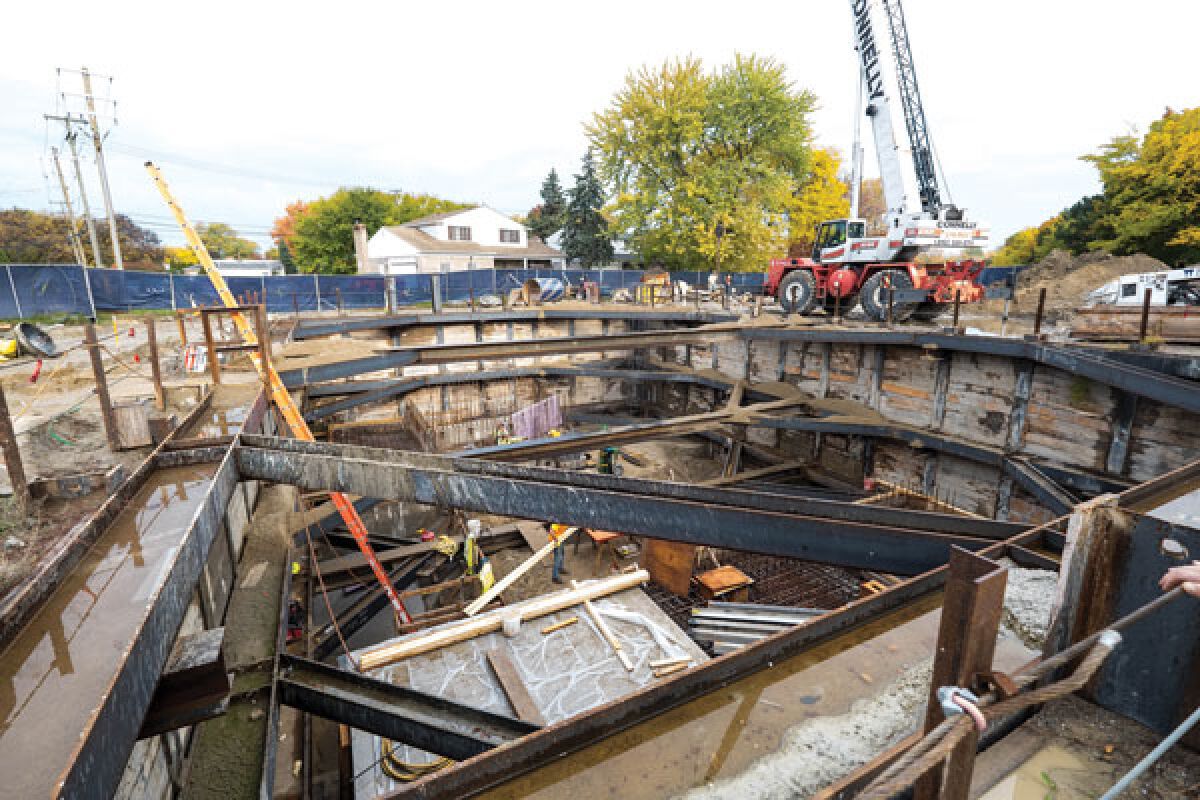EASTPOINTE — A public works project aimed at reducing combined sewer overflows in Eastpointe and St. Clair Shores is nearing completion.
In September 2022, Macomb County Public Works began excavation on what the department is calling an “in-system storage” project on Beaconsfield Avenue, south of Nine Mile Road in Eastpointe.
Workers dug approximately 50 feet below ground to reach a sewer pipe, which they then removed a section of to install a rubber weir. The weir, or dam, can be inflated during a heavy rain event and then released to allow the flow to be sent to the Great Lakes Water Authority’s Detroit wastewater plant for proper treatment rather than being discharged into Lake St. Clair.
The Macomb County Public Works Office stated that Beaconsfield Avenue, which has been closed throughout the project from Nine Mile Road south to Rosetta Avenue, might begin reopening by the end of December. The office believes that the project will be finished by the spring.
The $13 million project has been paid for using federal, state and county funds and is not expected to cause any increase in sewer rates, according to a press release sent by the Macomb County Public Works Department earlier this year.
The project is aimed at reducing the amount of combined sewer overflows in Eastpointe and St. Clair Shores, which happens when stormwater from a heavy rain event mixes with the sanitary sewer, overwhelming the infrastructure. In this area, the water is then sent to a treatment facility where it is treated before being released into the lake.
While the state permits the county to do this, Macomb County Public Works Commissioner Candice Miller said it’s “not right.”
“We need to do a much better job for our magnificent Great Lakes water quality and quality of life for the next generation,” Macomb County Public Works Commissioner Candice Miller said. “In Macomb County, we have a total commitment to protecting Lake St. Clair and we’re willing to spend the money.”
The project is expected to reduce combined sewer overflows by about 15%, Miller said, which is in addition to another 30% reduction created by changing processes and operations at the pump station.
While the work has been ongoing, residents in the area have “been great,” Miller said.
“This is a very, very busy road,” Miller said. “Some of (the residents) have said there’s a lot less traffic. … They’ve had to put up with all of the noise for construction. They have been great. I think they understand what the project is; how important it is for water quality in the lake.”
Eastpointe City Manager Mariah Walton said she hasn’t heard of any complaints from residents.
“The county has been incredible to work with on this project,” she said in an email. “They communicate regularly and are very thoughtful of the residents in the area. We have not had any complaints in this area during the construction that I’m aware of.”
How does it work?
Steve Rozycki, an engineer for Macomb County, said they realized early on that after some of the larger storm events, when water would be discharged into the lake, the tunnel — which has an internal diameter of about 11 1/2 feet, would only be filled by 3 or 4 feet.
“So that’s where we said, ‘OK, what can we do to force that storage within the existing tunnel,’” he said.
Once the inflatable bladder is installed, it will be able to inflate and seal the pipe, allowing water to be stored, Rozycki said. Smaller gates are being installed along bypass access chambers that will allow the county to control the flow being sent out.
“After the rain’s over, when we want to release that water, the small gates will crack open and we can slowly control how much flow we send out so we don’t just deflate the bag and send it off,” he said.
The reason behind the bladder being inflatable, he said, is to help prevent failure.
“One thing we always look at is, ‘What if it fails; what’s the ramifications of failure?’ … It’s basically a balloon that fills with air. The fail is, just open the valve and let the air blow out. The bag will deflate and let the flow go. Or if it doesn’t work during the beginning of an event, so what. It’s just like the existing system,” Rozycki said.
While a building housing all of the controls for the system has been constructed, Rozycki said it won’t have to be staffed, although employees will stop by regularly to check on the equipment and do inspections.
The project is expected to be completed by the end of this year and will be online early next year, Miller said. Once completed, all residents will see is an access hatch in the roadway and the small building that will house the system’s control units.
 Publication select ▼
Publication select ▼





















